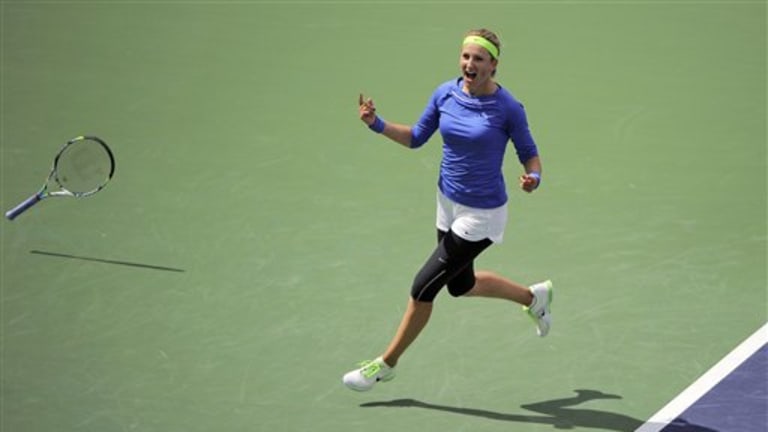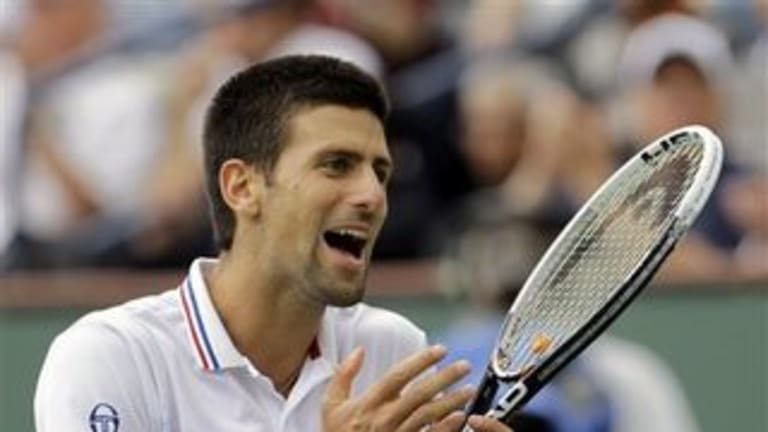by Pete Bodo
If you didn't know better, you might be easily convinced that Victoria Azarenka is Novak Djokovic in drag—an analogy that might amuse the Serb, the kind of guy who enjoys a bit of cross-dressing and might get a kick out of donning a blond wig and, playing air tennis, letting out a high-pitched "Who-o-o-o-o-o-. . . !"
In fact, the only aspect of the Vika-as-Nole theme that doesn't quite fit is Azarenka's shortcomings as a fashionista, as demonstrated by that weird shorts-over-tights look she brought to the Indian Wells final last Sunday. Not that I have problem with it; it's refreshing to have a female star who doesn't feel obliged to make a "statement" or wear a get-up that looks more appropriate for an Oscars after-party. But let's face it, Djokovic is a sharp-dressed man.
It was last year at this time and place (the Sony Ericsson Open) that Djokovic really broke through in the public consciousness, but it's also where he convinced most pundits, astute fans, and camp followers that this transformation was lasting, that he represented a genuine threat to the two men who had always been ranked ahead of him, Rafael Nadal and Roger Federer.
Djokovic was 18-0 at the onset of Miami with three tournament wins, and he had beaten his three main rivals in those finals: Andy Murray at the Australian Open, Roger Federer in Dubai, and Federer and Nadal—back-to-back—at Indian Wells. When Djokovic left Miami following an epic win over Nadal, he was the toast as well as the scourge of tennis, and would remain so until after the U.S. Open.
Azarenka embarks on her quest to win Miami with the No. 1 ranking in hand, and you have to like her chances. She's won this event twice and is—like her counterpart Djokovic in the men's draw—the defending champ. Like Djokovic early in 2011, Azarenka is the Australian Open champ and she's undefeated this year in match play. The 22-year-old from Belarus has won five more matches up to this point in the year (23) than Djokovic had at this stage in 2011. And like him, she hasn't quite convinced the world of her superiority yet, but would almost certainly do so if she concluded a clean sweep of the entire year-opening hard-court swing.
Azarenka is certainly aware of the footsteps she keeps stepping into; she even joked down in Melbourne about "being like Djokovic" when she pulled a package of gluten-free wraps out of her hotel refridgerator. And that was before she began to make her big move.
I imagine Azarenka knows that many fans must be thinking, "Sure she's doing great, but can she beat Serena Williams?"—conveniently forgetting that Vika crushed Serena, 3-and-1, for the biggest win of her young career in Miami in 2009. The two could meet in another final here, to jog our memory—or discredit it. It also hasn't helped Azarenka that despite the relative chaos on the WTA in recent years, she was unable to win a major until just a few months ago.
But even these qualifiers point toward parallels with Djokovic, not all of which are statistically based or entirely obvious. Let's look at some of them:
—Nole and Vika were both "slow-fast starters" as pros. They hit the tour early: Azarenka began playing Grand Slam tennis at age 16; by the end of that year (2006), she had turned 17—and made the third round at a major, the U.S. Open. Djokovic turned 18 during his first year of Grand Slam competition (2005) and he made the third round at two Slams (Wimbledon and U.S. Open). By the age of 19, both were established as Top 20-or-better players.
Djokovic won his first major in Australia in 2008, before he turned 21. But he didn't win his second until 2011. The prowess of Federer and Nadal certainly had something to do with that, but it's also true that once he became a star, Djokovic got a bit lost in the funhouse, and his game became a little rough around the edges, especially in the service and consistency departments. Basically, Djokovic matured late despite his precocity.
Azarenka is also a late-blooming prodigy. Part of that can be explained by the bad luck she had last year at the majors, losing to top women who were in form in the late stages at each event. Azarenka was playing well enough at those tournaments to be a credible champ at any of them. It just didn't work out for her, and maybe in the long run that was a source of motivation for her in 2012.
Like Djokovic, Azarenka got real, real quick.

